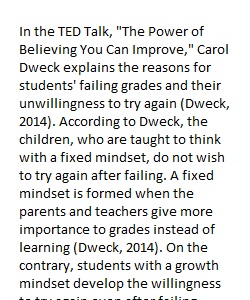


Q Here's a handout about words that can be used to modify how strong a claim is. I don't mean "strong" in the sense of "good," like a "strong paper." I mean "strong" as in a very bold statement, a statement that is difficult to defend. You need more evidence to support a strong claim than a weak claim. (I know that "weak" sounds negative. In this case, it's not.) For example, consider this claim: "No one can be financially successful unless they were encouraged to have a growth mindset as a kid." That's a very strong claim (a bold claim). Can it be disproven? Yes! All you need is a single example of a person who was not encouraged to have a growth mindset as a kid, but who turned out to be financially successful anyway. That one example would disprove this claim because the claim is too strong. It's an absolute claim, which means it does not make room for any exceptions. In the Strength of Claim handout provided here, there's language for generalizations that could help make this overly strong claim more appropriate. For instance, someone might write: "When children are encouraged to have a growth mindset, they often find school more rewarding. This enjoyment of school is good because education tends to increase financial success later in life." The words "often" and "tends to" both modify the strength of the original claim. With these modifications, if you found a single exception, it would not invalidate the claim. Even if you found a number of exceptions, this new claim could still be true. This claim is not absolute. It only says that many kids who are encouraged to have a growth mindset enjoy school, and that education is usually (meaning not always) correlated with financial success. This claim is more easily defended and comes across as far more reasonable than the previous, unmodified claim. Review the Strength of Claim handout. [Don't be thrown off by the fact that it's labeled "Academic Writing for Graduate Students." Undergrads who want to write persuasive claims need this kind of language too. :0) ] Save an extra copy of your final draft of Paper #1 to work with. Choose 3 claims and/or explanation sentences from your Paper #1 application paragraph. (You're looking for sentences that can be disagreed with. Both claims that introduce evidence and explanation sentences can be modified with SOC language because they are all statements that can be disagreed with.) Change the font color to red so that the 3 sentences you have chosen are easy for me to spot when I open your document. Modify those sentences by using the "Strength of Claim" language in the handout. Use whatever type/category is most appropriate for each sentence. You may also use more than one category in a single sentence if that makes the most sense. Remember that what determines how strong your claims should be is the strength of the evidence. (That's why you should gather the evidence first and then create the claim to match.) Submit this copy of your Paper #1 to this submission link. If you have any questions about how to use this Strength of Claim (SOC) language, please email me. This language is an essential tool in persuasive writing because it shows the audience that you are not overstating your case. You have sufficient evidence to back up what you are saying, which makes you more convincing.
View Related Questions